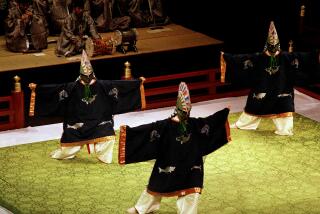Tone of Music and Dance Festival Was a Step Backward
- Share via
The so-called “International Festival of Music and Dance” at the Orange County Performing Arts Center on Saturday was an embarrassment to anyone with a serious interest in ethnic music and dance. Not because the performers--most of them, anyway--didn’t take their mission seriously. But because of the extraordinarily retrograde attitudes of the festival committee, co-chaired by Thomas N. Moon, Ruth Ding and Mary Bonino Jones.
The tone of the program--harking back alarmingly to the dark ages of international relations--could have been entertaining only to those Americans who think fuzzily of the “deep, dark, mysterious” Continent of Africa (a quote from Moon’s script) or who are amused when informed that the hips of Polynesian dancers “swivel in a manner that defies understanding” (another quote).
Intended to celebrate the ethnic diversity of Orange County, the event actually managed to demean it, with glib verbal stereotyping and--in some cases--peculiar choices of dance groups.
No effort was made in the commentary to delve into the significant aspects of a particular dance style. Instead, meaningless banter and self-congratulation actually undermined the ostensible purpose of the event, giving lip service to “quaint” traditions that are, in fact, the product of specific cultural situations.
At the very least, the audience could have been consistently told from what portion of the country the dance comes and what kind of dance it is (a recruiting dance, a courting dance, a wedding dance or whatever).
A few of the dance group choices were also ill-advised. On some level in the presenters’ minds, the idea of “international dance” seemed to have drifted away from ethnic dance per se to pleasant entertainment somehow associated with a specific country.
The first Performing Arts Center event to celebrate the Orange County Centennial, the evening was entirely colored by a hackneyed show-biz approach rather than the spirited-but-informed attitude of people seriously interested in ethnic dance. Even the emphasis on American tunes and American-style movement (four dance forms, if you count the drum majorette performing with the Santa Ana Winds--five, if you count the Hollywood-esque Formation Dancers) seemed contrived to echo the insular, complacently self-congratulatory tone of the event.
The inevitable condensation of slowly unfolding dances into brief dance digests suited to a TV-trained attention span is a phenomenon every ethnic group has to come to terms with. But the extreme brevity required of the dance groups gave them the impersonal look of variety show “acts.” (As it happened, stage preparations involved awkward lags in timing during which narrator Carl Princi offered lame jokes.)
It’s no wonder that a bland “that’s entertainment” mentality ruled the evening: Producer Ding is the only person connected with the administration of the festival whose listed credits have anything to do with ethnic dance.
The point is not that the evening should have resembled a lecture in anthropology. It’s just that the planners of the program seemed stuck in an outdated notion of multicultural “entertainment” as something for the middle-of-the-road armchair traveler, something inevitably perky and reassuring, with lots of squeaky-clean Americana, even down to a rendition of “America the Beautiful.”
The organizers of this event need have traveled no farther than Oakland to find an ethnic dance festival that is pan-cultural in the enlightened meaning of the word. (Ding, in fact, did visit the last one, in June.)
Held on two consecutive weekends, the San Francisco Ethnic Dance Festival, a production of City Celebration, consists entirely of Bay Area dancers (understandably an impossibility to duplicate in Orange County, where numerous nationalities are not represented by performing groups).
They are chosen by a panel of dance ethnologists, dancers with ethnic dance backgrounds, folklorists, ethnic dance teachers and dance presenters. The performances include no commentary from the podium, except for opening remarks. Salient information about the groups is printed in the program.
The ambitious time frame of this festival also means that each group is allowed from 10 to 20 minutes on stage to allow its movement style to begin to steep the audience in the sensibility of another time and place.
San Francisco’s festival is not the perfect way to showcase ethnic dance; no conventionally staged event could be. But the event doesn’t sell other cultures short--or package them like cute amusement park attractions.
More to Read
The biggest entertainment stories
Get our big stories about Hollywood, film, television, music, arts, culture and more right in your inbox as soon as they publish.
You may occasionally receive promotional content from the Los Angeles Times.










